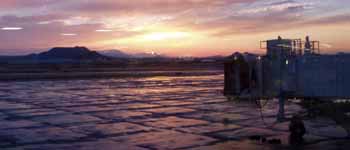
Copper Canyon
The American Orient Express - can you imagine. We had seen programs about the American Orient Express a number of times on TV. We decided that such a trip would be a terrific retirement gift to each other. Thirty-five years with the State of Maryland and and way too many years at Reese's Market - free at last....
Expensive? Absolutely! This trip was something for which we had to save and we had to plan well in advance. Everything was going to be first class, and we had never been even near first class.
This was the AOE's first venture into Mexico. They had several US trips and one into Canada. When compared to their other trips, this one did not go to places which we had visited in the United States or visited areas we had already seen. The Copper Canyon was supposed to be even bigger, deeper, more colorful than our Grand Canyon. One cannot travel to it or through it by car; the only way to visit is by rail. It looked terribly exciting in their publications. We were hooked.
After making the deposits and receiving all the detailed information from AOE, we were anxious to leave. We had two choices of trips, starting from El Paso, through Mexico and ending in Tucson - or - the reverse. Then the changes started.
First we were told the routes were from Tucson to Chihuahua - or - the reverse; the Mexican rails were so poor the originally planned trip had to be modified.
Then the dates were changed. We selected from Chihuahua to Tucson, but raised bloody hell regarding how to get to Chihuahua. Evidently we were not the only "concerned" potential passengers and we ended up leaving from Dulles International to go to Tucson and change planes to Chihuahua with our fellow travelers.
The trip from Dulles was OK. We were to fly out of Tucson somewhere around 10:00 am or so, but the plane was late. Actually, it was late because it was broken and we waited while repairs were attempted. Although we learned much, much later, the "airline" which AOE contracted had only two planes. About 3:00 pm it was determined that our aircraft could not be repaired and the other aircraft owned and operated by this airline was in Canada and had to be flown down to us in DC.
To make a long, tedious story a bit shorter, a group of very tired, uncomfortable, grumpy passengers were place in a Chihuahua hotel close to mid-night. We were to get up to go to the station at 7:00 the next morning.
Only that morning did we really determine this was a five-star hotel and had we arrived around noon as was originally planned, we would have had a terrific time just in the hotel. Such is life.
On to the rail station, where the real magic of the American Orient Express really start.
As you will see: we had a superlative trip; we rode in fully refurbished first-class railroad cars which have not been seen or used in perhaps 40 plus years; we had perhaps the best guide for all things Mexican, particularly the Copper Canyon, in the world; we saw wonderful sights and visited Mexican towns and villages; we had great five star chef prepared meals; we touched only cloth, silver, china and crystal for 10 days; we made life-long friends, and established traveling companions for years to come.
So we start -
>>>>>>>>>>>>>>>>>>> - - - - - - - - <<<<<<<<<<<<<<<<<<<<
As we arrive at the Chihuahua Airport - pretty - but we're too tired and frazzled to appreciate the view.

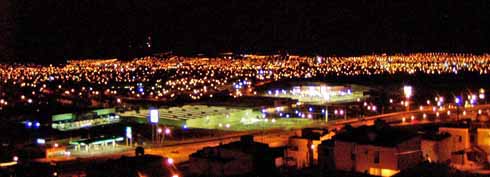
Chihuahua from our beautiful suite - at night,
 and
in the morning.
and
in the morning.
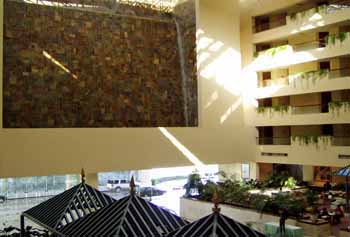 The lobby as we ate breakfast. The rock wall in the upper left of the
picture was the air conditioning. They allowed water to flow over the rock
and the temperature dropped 15 degrees in as many minutes.
The lobby as we ate breakfast. The rock wall in the upper left of the
picture was the air conditioning. They allowed water to flow over the rock
and the temperature dropped 15 degrees in as many minutes.
However,
Its all about the train - the American Orient Express
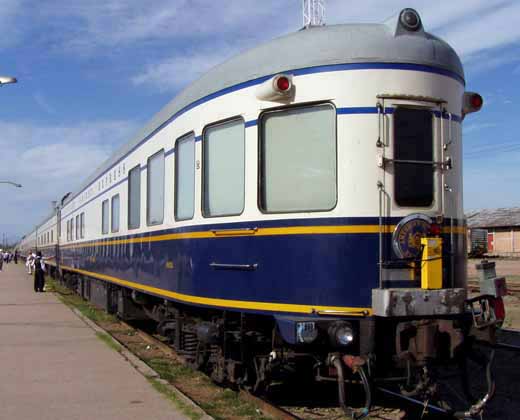
The very famous rounded lounge at the end of the train.

The inside view - yes those are fresh flowers - everywhere, at all times
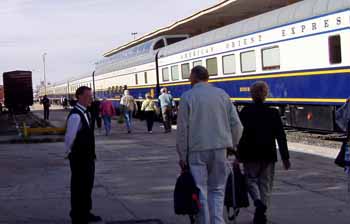 But
first, we have to board, guided by our porters
But
first, we have to board, guided by our porters
and they guide us to the correct car
and down the hallways 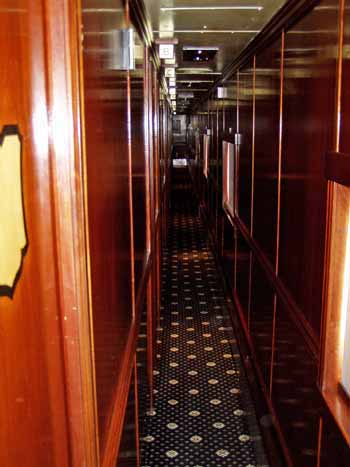
where you find your stateroom 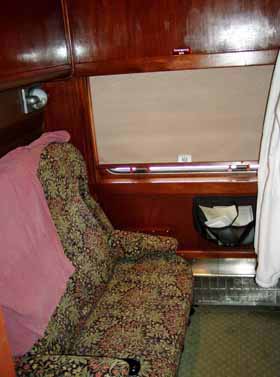 Yep,
you're seeing both sides of the room. I've now forgotten, but the sofa and
the cabinet above rather ingeniously become bunk beds - and not that uncomfortable!
To the right is the bathroom; the door is open so you see the terrycloth robes
furnished for us.
Yep,
you're seeing both sides of the room. I've now forgotten, but the sofa and
the cabinet above rather ingeniously become bunk beds - and not that uncomfortable!
To the right is the bathroom; the door is open so you see the terrycloth robes
furnished for us. 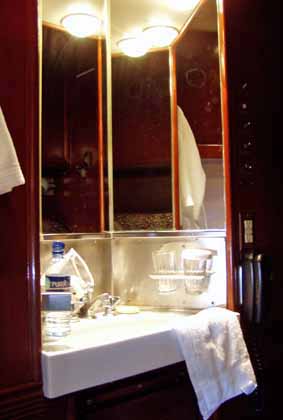
You check out your bathroom, find places for your luggage and very ingenious places for hiding the bags,
 and you settle in.
and you settle in.
Down the hall is a rather nice shower room. One makes reservations for its use with one's porter, who prepares the shower with warm towels and other items
You then start wandering around and see where to go and what to do while aboard.
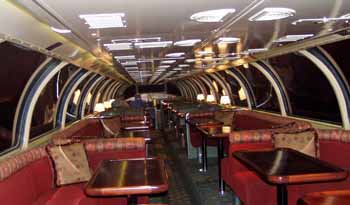
This is the upper deck on the glass topped observation car in the evening
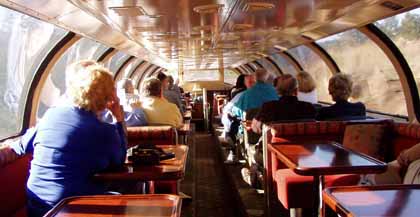 and
then again while we're on the move
and
then again while we're on the move
The bar in one of the lounge cars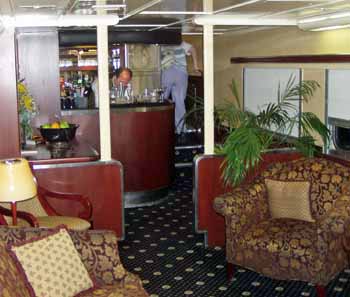
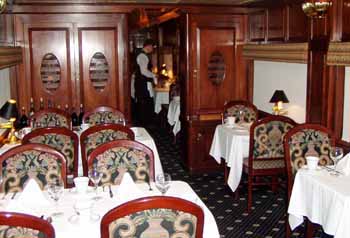 One
of the dining cars
One
of the dining cars
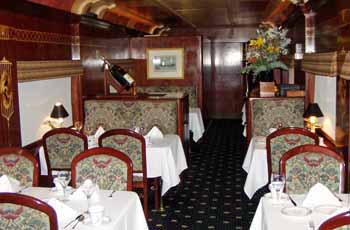
and one of the other dining cars - yep - linen, silver, china and crystal, and attentive waiters offering your choice of at least three different meals and appropriate wines
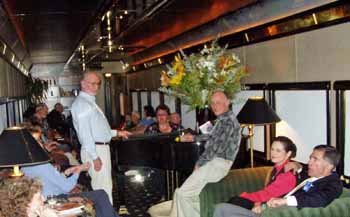
After dinner, how about a visit to the piano lounge
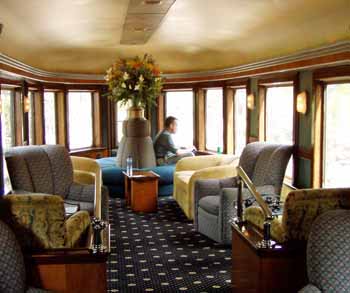 or
back to the end observation lounge
or
back to the end observation lounge
maybe a drink to relax in the bar in
another lounge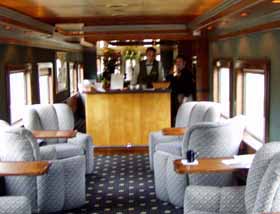
And there are some special people to make friends with while on the train
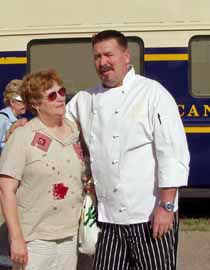
One is the famous Five Star Chef (ask Jackie about lobster frittatas or Pam about chocolate cake for breakfast)
one of his cooks
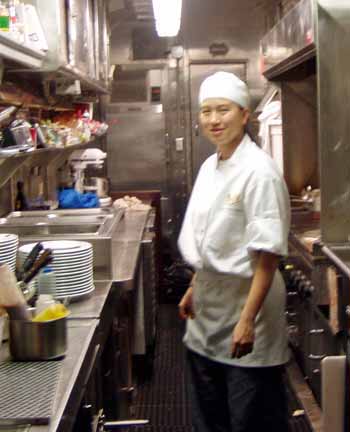
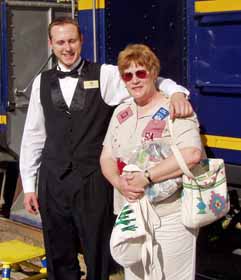 Another
is Jackie's friend - our berth's porter
Another
is Jackie's friend - our berth's porter
or my friend, the lounge bartender
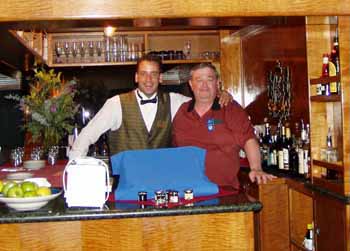
And yes, this is a very long train; perhaps one/half mile or more
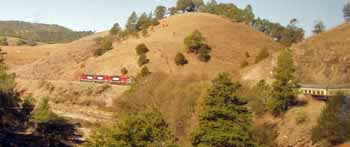 with
three engines
with
three engines
and a long line of passenger cars.
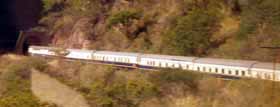 long
enough that I'm in the last car, back around a curve, taking pictures as the
train is entering a tunnel, where the engines and support cars have already passed
in and out of sight.
long
enough that I'm in the last car, back around a curve, taking pictures as the
train is entering a tunnel, where the engines and support cars have already passed
in and out of sight.
And yes, there were armed men between every car - day and night. We had only one instance of an attempt to board the train and one instance (that we know about) where someone took a shot at the train - leaving a bullet mar on one of the windows in the last car.
But how about the reason for the trip - the Copper Canyon?
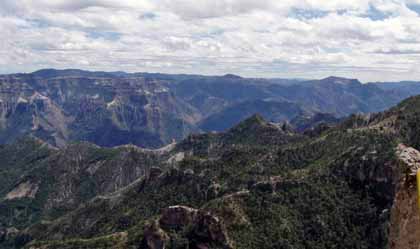 The canyon has many personas -
some
green, some dry, some just rocky - always steep, deep, jagged and mysterious.
The canyon has many personas -
some
green, some dry, some just rocky - always steep, deep, jagged and mysterious.
The question is - "How many pictures could possibly be enough?"
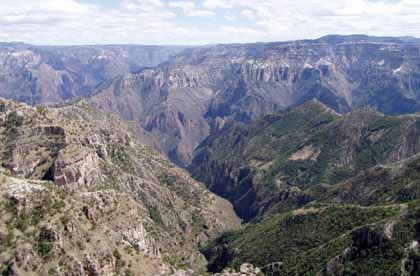
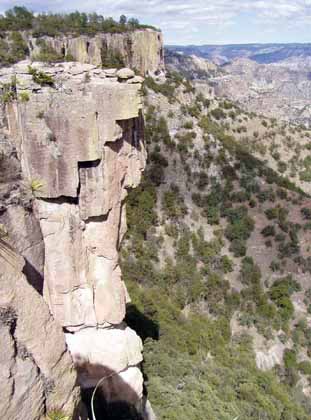
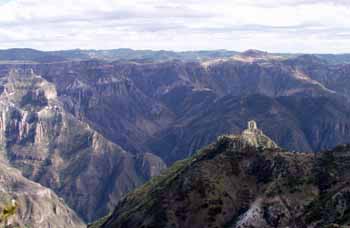
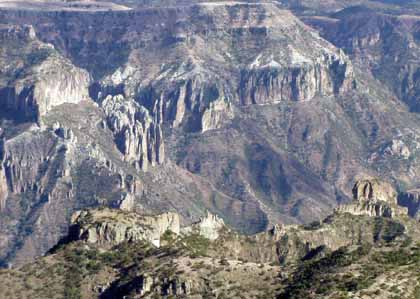
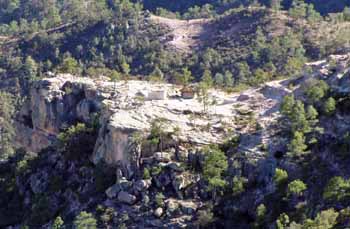 By
the way, can you see the small farm below, in the center of the picture on the
left?
By
the way, can you see the small farm below, in the center of the picture on the
left?
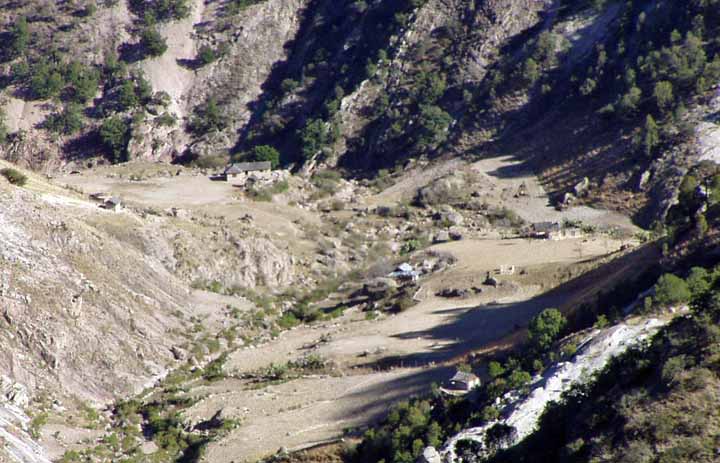 Here's
another - taken with a telephoto lens! There
are NO ROADS - simply paths. If its here it was carried in or built
here. On the farthest plateaus entire villages exist - a two day walk from
the rail. Our guide was originally from one of these villages.
He, and other like minded guides, go back each year carrying medical supplies
and other necessities to their villages. Again, a two-day hike in and a
two-day walk back.
Here's
another - taken with a telephoto lens! There
are NO ROADS - simply paths. If its here it was carried in or built
here. On the farthest plateaus entire villages exist - a two day walk from
the rail. Our guide was originally from one of these villages.
He, and other like minded guides, go back each year carrying medical supplies
and other necessities to their villages. Again, a two-day hike in and a
two-day walk back.
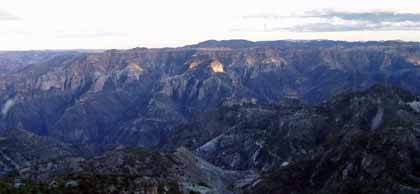
Simply wondrous!
Rivers run to, and through the canyon.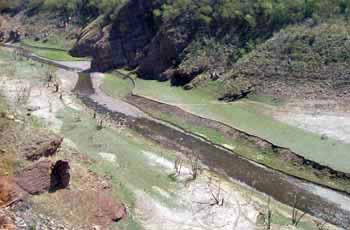
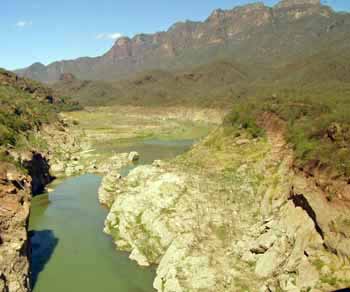
There are a lot of unusual views as we go down the rails. The area is so remote and territory so difficult that if a rail car(s) derail, they are left where they fall. We lost count of the overturned cars we saw on the side of the rails. The was even one instance of an engine left to rust. Makes you wonder about how safe the rails are.
The rails and rail beds are so bad that often walking down a hall, one bounced pretty roughly from side to side, wall to wall, as if at sea. Gauging from my experiences later on the trains to work, I'd imagine we never exceeded 30 miles an hour on the best day. We seldom, if ever, traveled a night.
Sidings were few and far between. Many were so short they could not accommodate our train, so often we had defacto right-of-way. There were very few other trains, but as you see below, as there are no roads into the Copper Canyon, if you had a camper, this is how you "drove" the canyon.
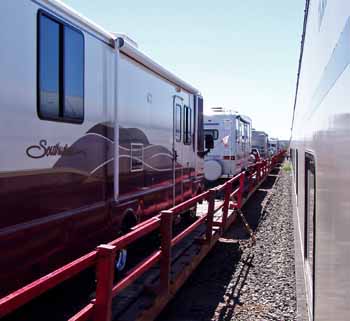 Yes,
these are various campers and trailers on open rail cars. We're on a
siding as these went by. Not pictured are the occupants out between the
campers on lawn chairs, drinking beer, taking pictures, playing
their radios and generally enjoying themselves, as the train goes north through the canyon. Remember, no
train is going any faster than perhaps 30 mph.
Yes,
these are various campers and trailers on open rail cars. We're on a
siding as these went by. Not pictured are the occupants out between the
campers on lawn chairs, drinking beer, taking pictures, playing
their radios and generally enjoying themselves, as the train goes north through the canyon. Remember, no
train is going any faster than perhaps 30 mph.
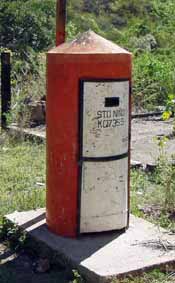
Here, believe it or not, is railroad stop.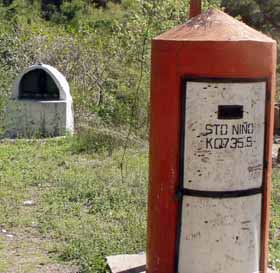
After I took the picture, I noticed a shrine
behind the stop. Normally found along side
a road, they indicate a death remembered.
Other sights, and there hundreds too many to photograph, or photographed and now to share, such as numerous instances where we went through tunnels (none on my "dramatic" going in or coming out of tunnels shots were any good), when we went around loops, or simply gazed at the beautiful country side. The changes in the country as we went through the canyon were easily recognized and we have innumerable pictures of brush, trees such as kapok, and cactus. Strangely enough, as I remember it, we saw no wildlife other than birds.
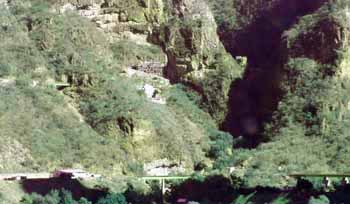
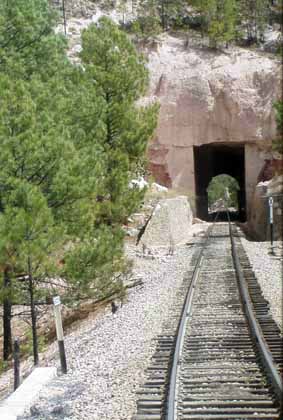
There was much more to the trip than riding the rails
No, not all our time was spent on the train. We stopped maybe two or three times a day for sightseeing right along the tracks, with bus rides and trips to villages for tourist attractions.
We were fortunate on our first outing to have Pedro as our guide. After that first stop with him we did whatever was necessary to get on his bus, in his group or walk as closely as possible to him the entire trip.
Everyone Knows Pedro!
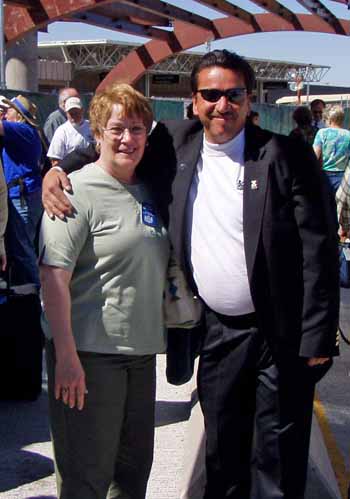
Pedro is one of the most extraordinary men I've ever met - period!
Forgive me as I spend a couple minutes about him. He was born on one of those plateaus seen in the distance on the far rim of the canyon. His mother carried him and his brother to Chihuahua and "gave" them to the church for care. Pedro told me when I asked how many advanced degrees he had, that he escaped from school in the seventh grade, after six earlier attempts where he was caught.
After his escape, he lived on the street shining shoes. He did so many American shoes, he picked up English. Many of the Americans were in Chihuahua looking for tourist guides. He felt he knew enough to be a guide, so became one - on his own. He developed perfect English, read everything he could lay his hands on and has become one of the most sought after guides around. He is one of the most knowledgeable men I've ever encountered.
I mentioned earlier his trips to the plateaus each year. In addition, he attempts to bring other "unknowns" into his trips into the county side. For example, on one side trip, there were four buses. Pedro and we were in the last bus. He let the others get ahead - actually out of sight. He told us we were going to stop a a bus stop where he often saw two old men. Sure enough, there they were. He got off, huddled with the men, some money changed hands and he got back on the bus. He told us the men were selling famous Mexican wares - which could not be purchased just anywhere.
First he took out a small bottle of a course powder - which proved to be ground up rattle snake. This was used to cure various ills - he had often used it. We were invited to take a bit, feel it and if we wanted, taste it. Then he passed about a small bottle with some light grey/green, pea sized round things in it. He warned us to absolutely not take the lid off, not taste the contents. There were a rarer Mexican hot pepper. They cannot be cultivated, but only searched for. This is because a chicken has to eat the pepper seed and later "deposit" it on an appropriate piece of ground, where, with luck, it will grow. There old men scoured the country side looking for these widely distributed plants and picked the peppers for curing and then for sale.
Lastly, he was known for his generosity. At one stop for the night, we were beside what could only be described as a hobo village. There were an seemingly endless line of cardboard, canvas and tin huts and lean-tos. All the men there were out of work and had no money. There was also one long thin building. In that building was a woman who attempted to care someway, somehow for these men. She cooked meals, but as she was supported by no organization or charitable program, she had to charge one (1) peso (approximately seven (7) US cents) for each meal.
You can image how we felt, eating a full three course dinner on silver and china, while we see smoke coming out of the kitchen area in the hobo village. We learned later that every time Pedro comes by this spot, as he did this evening, he leves maybe 500 pesos with the woman so she could give out some free meals to those who could not pay their 7 cents.
Literally - Everywhere We Went - Everyone Knew Pedro
We we made innumerous stops.
Sometimes we simply walked into a small village to see something there, or through the village to see something within walking distance.
For example:
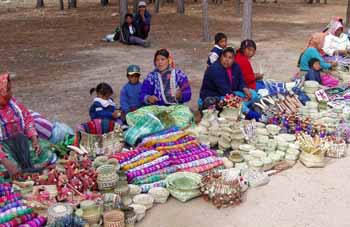 Often,
where ever we would get off the train there were women, with their children,
selling their wares. While some products were made by the sellers, very
many of the items from whole sellers or middlemen.
Often,
where ever we would get off the train there were women, with their children,
selling their wares. While some products were made by the sellers, very
many of the items from whole sellers or middlemen.
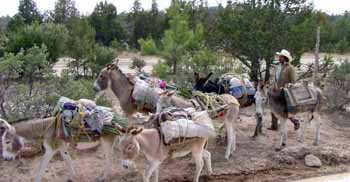
At some points we would see locals going about their business. Not everyone we saw on our stops were part of the tourist trade.
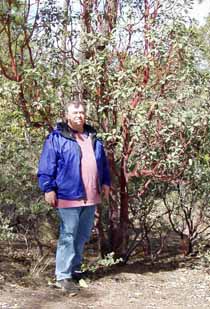
Some stops could produce outstanding pictures. Unfortunately the camera did not pick up the blazing red of the branches of this bush - thus leaving a fairly poor picture of some fat guy
Some stops were both spectacular and saddening - and later made one feel guilty.
Take a look below
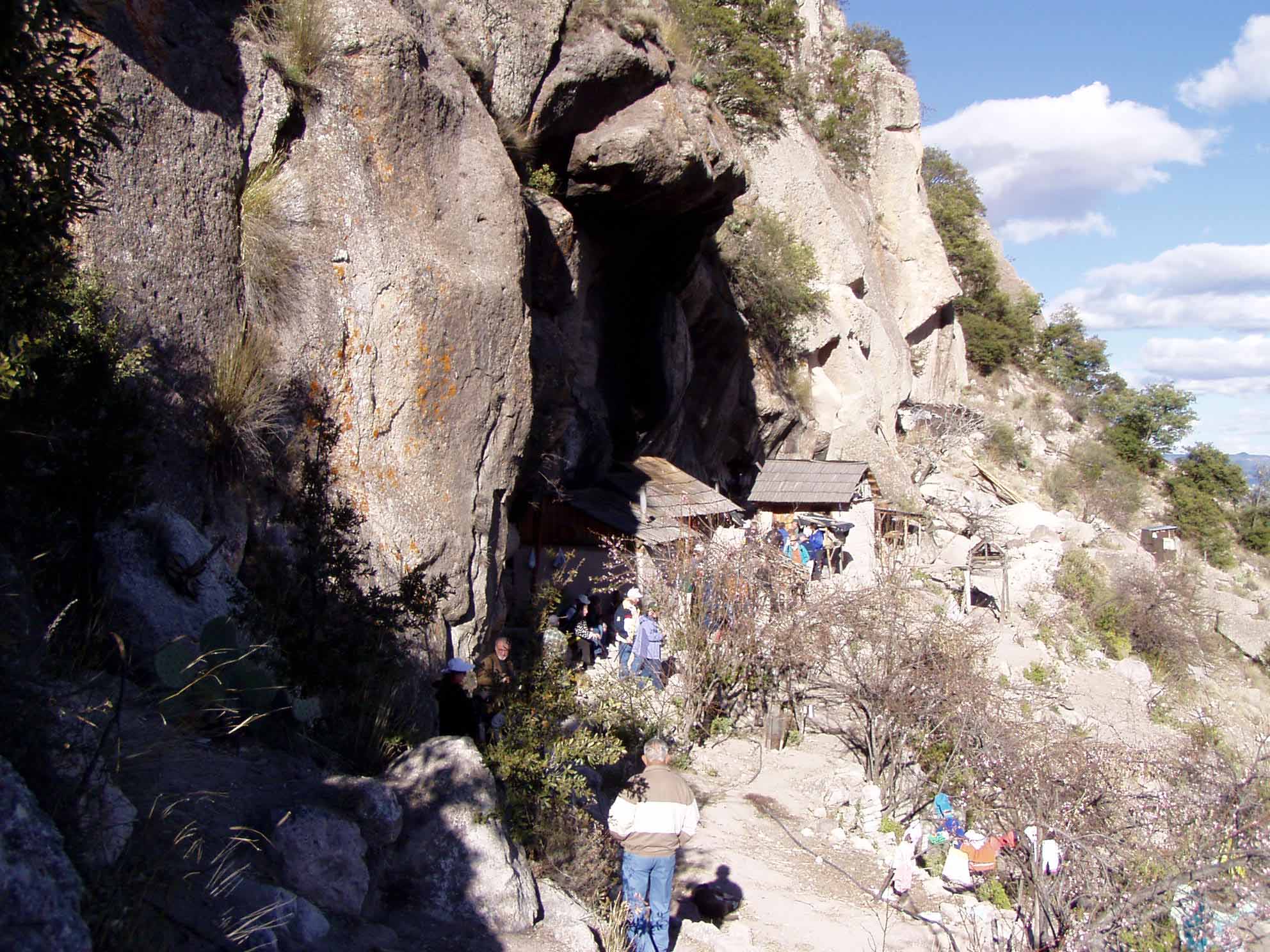 Here's
an other angle below
Here's
an other angle below
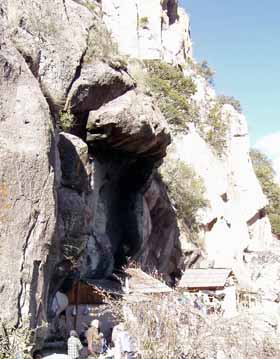
Do you see the home built on the cliff, in a depression or partial cave? Here's a closer view
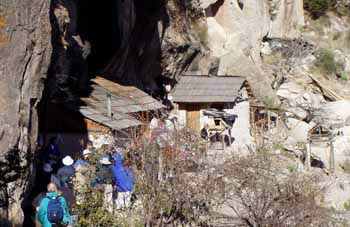
Down the path we went, past two children. They were sophisticated enough to know to ask for money to take their picture. They didn't know English, but knew to hold out one hand, and with the other, hold up one finger. Two dollars later, we went further past them down the rocky path.
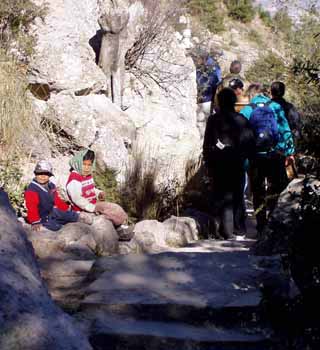
Here, Pedro told us about the single native Indian mother, with three children, the youngest in his arms. She lives here, chops her own wood, et al, and makes any money by having tourists visit to hear her story and ask about her life.

Following the visit, we walked back up the steep cliff-side path.
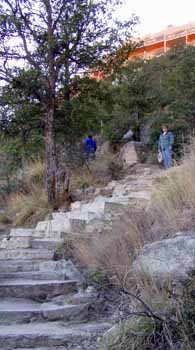
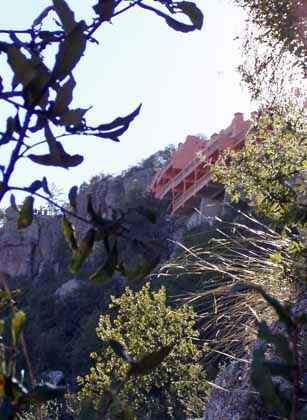
To where were we walking? To the right you'll see a beautiful restaurant with a fabulous view of the Copper Canyon, the river and the plateaus in the far distance.
As you might guess after this "strenuous" walk we had a terrific Mexican meal.
As said earlier, some stops offered the spectacular - in this case the view, the cliff, the restaurant built on the edge. They offered sadness - seeing this woman with her three young children living in shacks on the edge of a cliff. An then some guilt - after seeing her cooking over open flames on a "stove" made of a rock circle, we go to a great meal in wonderful surroundings, served by a gracious staff.
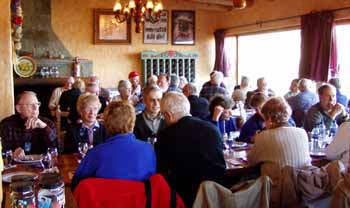
But not all stops were like that.
(In our journal you can keep track of where we were, when we were there and what we did, in some detail. However I'm skipping around as I offer the pictures.)
Some excursions, admittedly a very few, looked good on paper, but really didn't pan out the way QOE led us to believe. These were few, as said, but one or two were a real bust - as follows
Here we made a stop to take a
"river cruise" and see all the wildlife that lived along the river.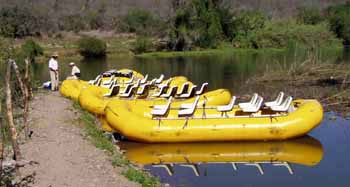
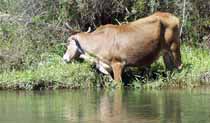 Discounting
fauna with wings, here's the wildlife we encountered.
Discounting
fauna with wings, here's the wildlife we encountered.
And the river was pond smooth, per se, which was just as well as I don't think any of us were the swimming through the rapids type.
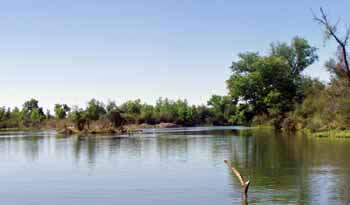
OK, there was some wildlife - try a bunch of buzzards and a crane.
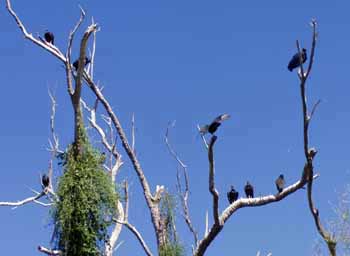
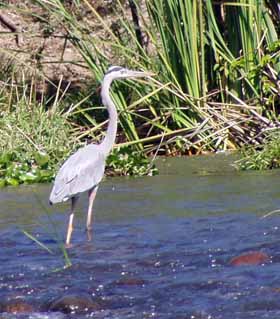
And where were we headed following this wild adventure? It appeared to be a castle.
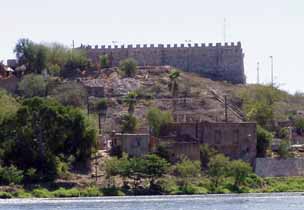
I will admit we saw huge clumps of the
most gorgeous bougainvillea we have ever seen on the walls surrounding the
castle. 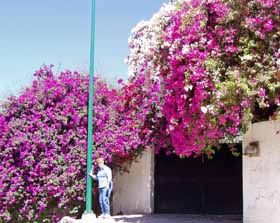
And what was the castle, and why were we there?
To eat, of course!
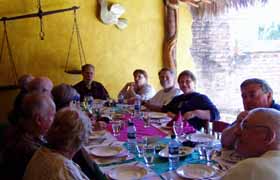
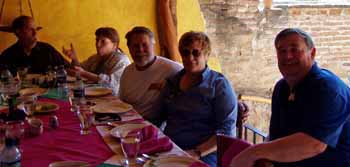
And here's OUR GANG. In the picture on the left, we see (left to right) Charles and Pam Bullock, then Andy and Kathy Nyhuis, and then me - Jackie's taking the picture. In the picture to the right, the same cast of characters, with Jackie sitting in while Kathleen takes the picture.
There you see friendships made on this trip that still exist today - at least 15 years or so now. There has been one piece of tragedy in the years following this picture, but I think we will all rather remember visits made to homes, brief meetings and meals in the midst of trips, and of course the wonderful times when we were again fortunate to travel together.
Following most every meal while off the train, we had some form of entertainment.
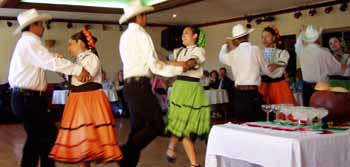 From dancing
to singing
From dancing
to singing 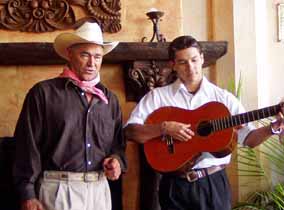
And then there were the bus excursions
Trips on busses normally are not too much fun. But given clean, air-conditioned rides over short periods, with Pedro talking - actually teaching - we had no complaints. Of course, with Pedro, we had unexpected variations that differed from those riding in the other busses. (Pedro and we always seemed to be on the last bus) It was not out of the ordinary for Pedro to stop in the middle of a lecture, for instance on Mexican land ownership laws, point out a rare bird or a field of unusual crops.
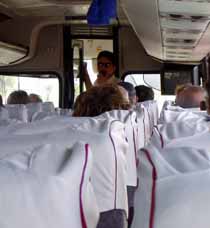
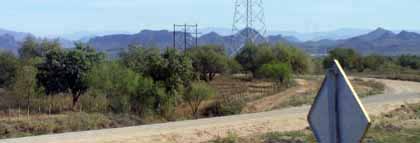
The roads were often dirt or dusty, but allways offered great views and scenery.
So here are pictures from some stops - in no particular order or sequence.
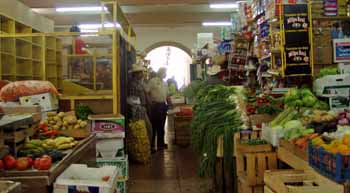
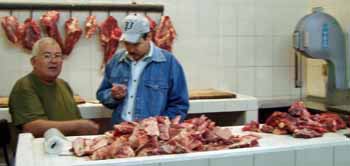
A local market in the middle of a small town. Beautiful vegetables and meat - but I'd like a bit more refrigeration
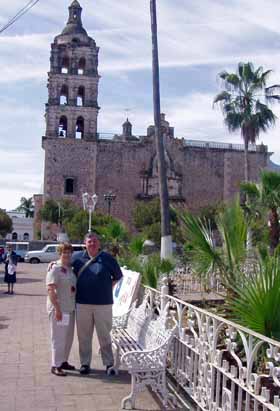
Most every town, regardless of size had its church. All seemed old, but other than the effects of age, all were maintained - and we never saw one that did not have worshipers in it, regardless of the time of day.
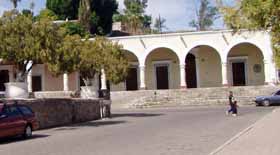 Some
of the stops included museums. Notice please, all the streets of every town
that had paved rather than dirt roads, were constantly swept and clean.
Some
of the stops included museums. Notice please, all the streets of every town
that had paved rather than dirt roads, were constantly swept and clean.
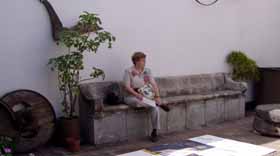 Jackie
takes a rest during a museum visit
Jackie
takes a rest during a museum visit
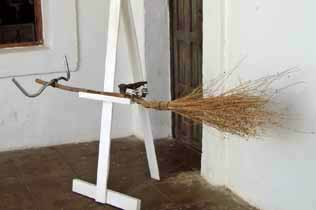 No, I
haven't a clue why it was there - and it was years too early for a Harry Potter
spoof. But regardless, I could not refuse the opportunity for a
picture.
No, I
haven't a clue why it was there - and it was years too early for a Harry Potter
spoof. But regardless, I could not refuse the opportunity for a
picture.
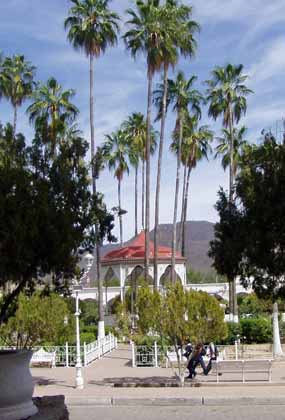 It
seems every town had a square - some more grand than others, but all seemed well
cared for, and many complete with teenagers in love.
It
seems every town had a square - some more grand than others, but all seemed well
cared for, and many complete with teenagers in love.
The more spectacular squares were full of plants and trees 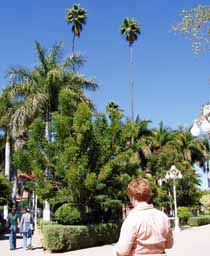
Even light posts and benches were decorated 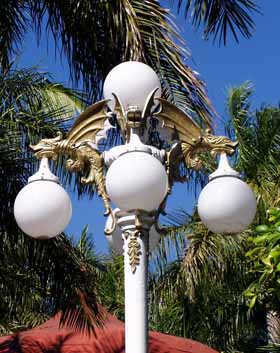
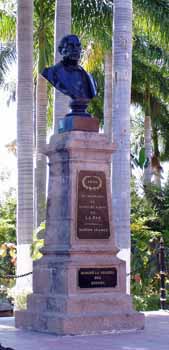 Many
had statues of national heroes
Many
had statues of national heroes 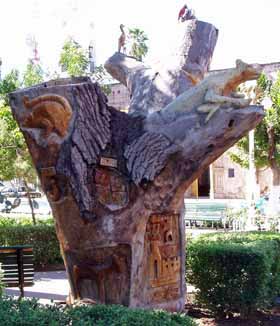 And
some had unusual pieces of art - such as this carved tree stump
And
some had unusual pieces of art - such as this carved tree stump
Every town had its own flavor and appearance; one could never say, "I can't tell one town from another, they all seem to look the same to me."
Some had fantastic government buildings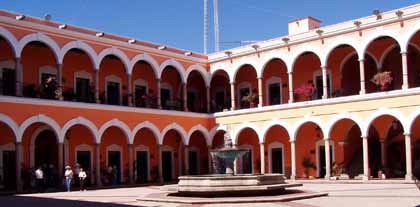
with simple but graceful architecture and, as below, beautiful centerpieces, like this fountain.

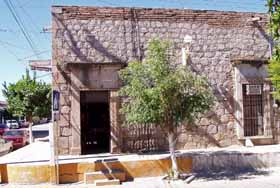 Other towns still had
buildings from an earlier age. Yet however rough, again they have clean, simple architecture,
remained attractive, and seldom were the unoccupied.
Other towns still had
buildings from an earlier age. Yet however rough, again they have clean, simple architecture,
remained attractive, and seldom were the unoccupied.
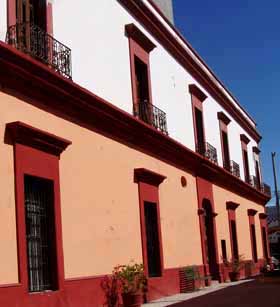 But
the colors! the iron work! the arches!
But
the colors! the iron work! the arches!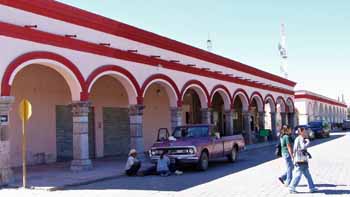
Many of the stops were for visits to small villages or groups which were intended to educate or entertain
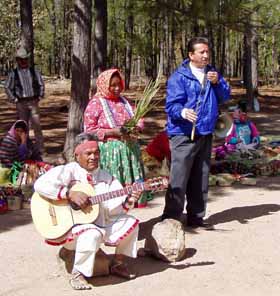 Here
Pedro introduces singers at a village and dancing breaks out
Here
Pedro introduces singers at a village and dancing breaks out
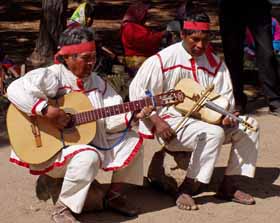
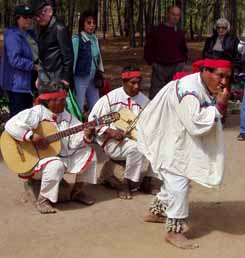
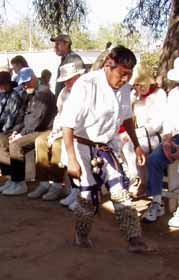
Notice the Tarahumara Indian dancers' leg rattles.
They are cowry shells, here in the dry middle of Mexico.
At another stop we learn about an ancient Tarahumara Indian sport for men called Rarajipa. They hit and then chase to hit again a hand-carved wooden ball, called a bola . When they reach a certain point, they go through the same steps to get back to the start.
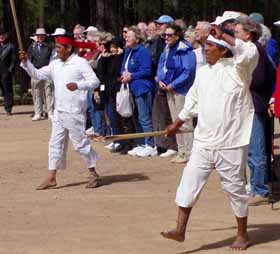
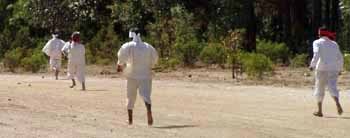
I brought back a bola to add to may baseball collection.
There were also women's games, but unfortunately, no picture were adequate to show
At another stop we again saw dancers. These were old Indian dances for good harvests and successful hunts. One of the dancers had brought his son to learn the deer dance and probably learn to perform for gringo audiences.
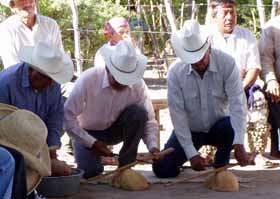 The instruments played here are not truly percussion, they are sticks - bows -
pulled against other carved, notched sticks, held on coconut husks. A very
unusual and captivating sound. I'll end the visit segment with a
story about these instruments which still almost brings me to tears.
The instruments played here are not truly percussion, they are sticks - bows -
pulled against other carved, notched sticks, held on coconut husks. A very
unusual and captivating sound. I'll end the visit segment with a
story about these instruments which still almost brings me to tears.
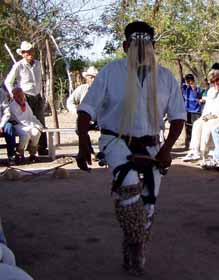 This
dancer is performing a harvest dance - again with legs covered with
cowry shells to provide rhythm
This
dancer is performing a harvest dance - again with legs covered with
cowry shells to provide rhythm
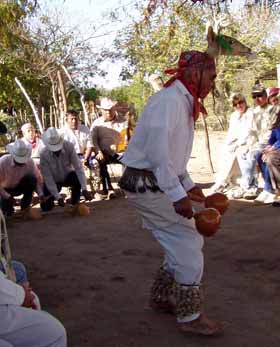 This dancer is performing a dance for a good hunt. Notice
the deer head tied to his head. Again the cowry
shells, but in addition the instruments played, he uses rattles to
produce additional rhythm
This dancer is performing a dance for a good hunt. Notice
the deer head tied to his head. Again the cowry
shells, but in addition the instruments played, he uses rattles to
produce additional rhythm
His son dances beside him late in the program - encouraged to copy his father's steps, chant and rhythm
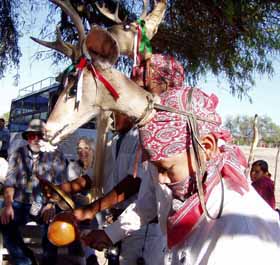
As I said earlier, I have a tale to tell about those carved stick instruments.
Jackie and I always purchase a carved piece representing each country we've visited. In one town I noticed a shop with some fairly primitive carvings in its single window. I walked in, ducking to get through the door to find a dirt floor and some shelves against the wall, with the window the best source of light. Far back in the dark rear of the room was a very old man - unnocitced at first. I asked him how much several pieces were and he could not answer. We turned and were about to leave when a young man carrying a couple books and a backpack came in and asked if he could help us.
I told him I asked about prices but the old man wouldn't answer. He explained he was "pure" Tarahumara Indian, with no family, and spoke no Spanish or English, only his native tongue. The young man said he came often to help the old man. I asked how he communicated and he told me he knew a small amount of the native language and between that and hand signals, they could get along. I asked how he learned to speak English; was it in the junior college he attended? He said no, he had learned English by watching subtitled movies.
To make a long story short, I saw the instrument used in the hunting dances and decided to buy it. When we purchase carved items, we always buy from the artist and always get the item signed. I asked the young man if he could have the old man sign the carving. He took the money to the old man and then had a long discussion with him. He finally came back and I felt the answer was probably no. The youngster said the old man could not sign the work, but would carve his initials in it, as he did not know how to write - was it OK if the young man made the marks on the wood in pencil and then the old man carved them? Yes, of course.
I never see the piece or think about the incident without thinking how very fortunate I am, and I get terribly depressed thinking about how the old man survived. I wonder to this day if the young student continued to help him and if he lives on, or only in my memory.
Many stops included churches, most in towns, but some, as in this 17th century church ruin, seemed to be out of the way and isolated
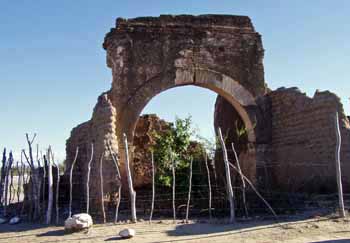
I've forgotten the story about this old, old church. I'll have to read the trip journal after it is typed. however, the church beside it was over 200 years old and replaced the one that collapsed. The interior of the old church was colorful and well care for. Notice, regardless of the hour, there are people worshiping.
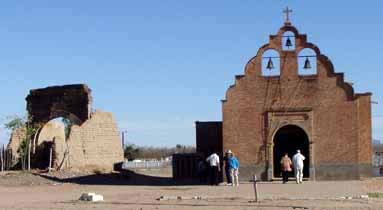
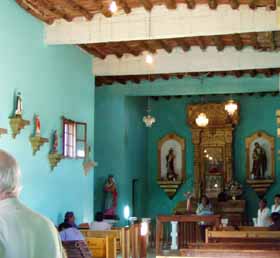
Some stops were to learn about the history of Mexico. This stop was at Poncho Villas' home. Outside the home was a statue of him on his horse. A bench was out front.
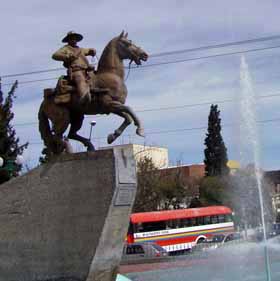
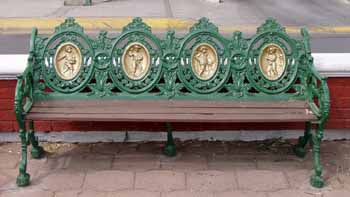
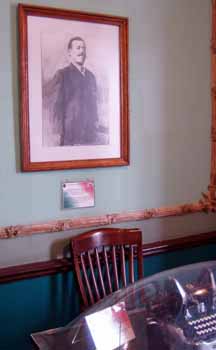 Out
in the garage was his car, full of bullet holes. In his office his
writing desk and typewriter were on display along with books and other
memorabilia, as were found in all the other rooms.
Out
in the garage was his car, full of bullet holes. In his office his
writing desk and typewriter were on display along with books and other
memorabilia, as were found in all the other rooms.
In his bedroom, one finds his picture,
his chair, his bed - and hanging on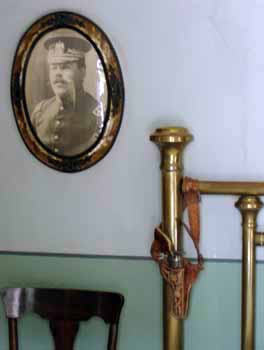 the bed hangs his pistol.
the bed hangs his pistol.
Down the street was this building with the beautiful interior plaza with phenomenal paintings on the walls (exposed to the weather), and nearby this cathedral .
Not all was joy and happiness. The board below was posted with the names of Mexican women who had disappeared. This is not the only such memorial, but this one represents women for only this town.
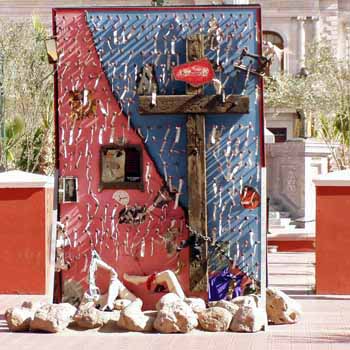
On to another stop - Whale Watching
Yes, we had crossed Mexico from Chihuahua to the west coast, or rather, the east coast of the Gulf of California. We were disembarked to go out into the Gulf to find whales. We were divided up into smaller groups and loaded into maybe ten boats. We happened to be on the same boat with Senator Chuck Rob and his wife Lynda Johnson Rob. They were on the train trip with all of us.
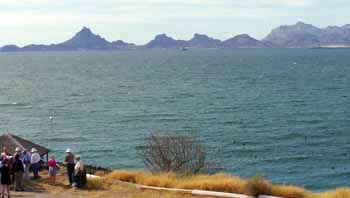 Out to the boats and the Gulf.
Out to the boats and the Gulf.
We pass by any number of very beautiful,
very expensive homes.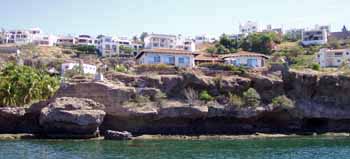 All of which are owned by retired Americans - as were the boats. It
seems we've tripped upon a retirement wonderland!
All of which are owned by retired Americans - as were the boats. It
seems we've tripped upon a retirement wonderland!
 The
passage out to the Gulf passed some impressive channel
walls and surrounding hills
The
passage out to the Gulf passed some impressive channel
walls and surrounding hills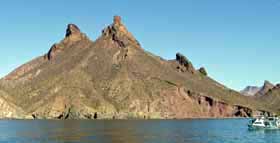
And out we go -
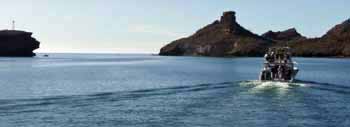
To be honest, we were out perhaps an hour or more. What excited me were schools of shrimp (do shrimp travel in schools?) We hunted and hunted, the boats split up and each searched on their own. In the end, I don't recall what others saw, but you will find our sole whale sighting below.
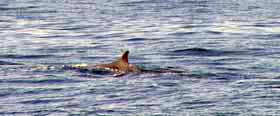
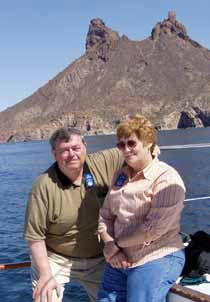

None-the-less, we saw some pretty scenery, some beautiful water, were on a smooth sailing craft, with good traveling companions and all this with the best wife in the world. Got a sunburn - what more could I ask for?
And so the train trip ends -
But the adventure wasn't over! We had to get across the boarder.
We pack our bags, said goodbye to the staff and started this last bus trip to Tucson. As we approached the boarder Pedro warned us that the Federals and customs personnel would go down the aisle of the bus. I don't recall now if we had to show papers and such, but we were warned that these guys are often a law into themselves and not to cause any disruption, not even look them directly in the eye. Sometimes they simply walk the aisle and other times they take more extreme measures.
So, on the bus they come. Next thing you know all of us are ordered off he bus. All the luggage is taken out from under the bus (there were either 3 or 4 Greyhound type buses) and spread all over the tarmac. We were then told to find our luggage, take it aside and then stand with it. Then any number of bags were opened and all the contents pretty much dumped while customs folks went through it. Then we had to take the luggage back to the bus, get back on and then wait to be told we could leave. Honest, as awful as I get at security stops and customs, I didn't cause this!
On To Tucson
We had a full day layover before our flight home. Our new friends, Andy and Cathy lived in Tucson. They invited us over to their beautiful home. They had natural landscaping with native plants and rocks. In the back yard they had a pool made with native stone with a spring like overhang that circulated the pool water. Beyond their back yard was a dry river bed, so one could go out the back of the house and and walk seemingly for miles. We went for a short walk and Andy constantly reminded me to watch out for the cactus. We had a great visit. Both Kathy and Pam told us to go to visit the Sonora Desert Museum and then drive through the Saguaro National Park. Bless them - this was the perfect way to end our trip!
Sonora Desert Museum
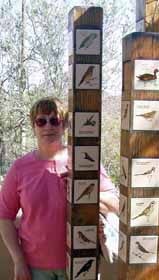 The entire museum is open and outdoors. Jackie is standing
next to one of several displays of the birds one might see while
visiting. You walk down winding paths to see displays, wild animals,
demonstrations and breath-taking scenery.
The entire museum is open and outdoors. Jackie is standing
next to one of several displays of the birds one might see while
visiting. You walk down winding paths to see displays, wild animals,
demonstrations and breath-taking scenery. 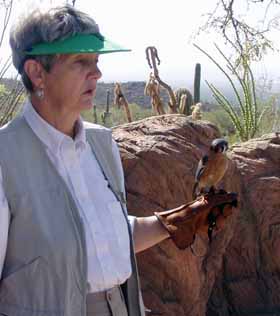 We
were fortunate to be in
We
were fortunate to be in 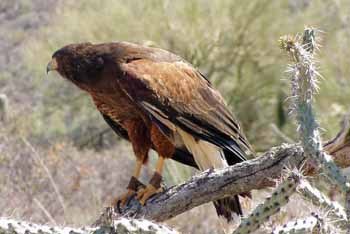
time for a demonstration involving several of the hawks that live in the desert. They flew up and around us and actually did routines where two would work together. As it turned out one of the hawks really didn't want to come back as quickly as the handler wanted and we had to wait for about 15 minutes before it made up its mind to rejoin us.

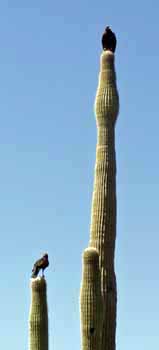
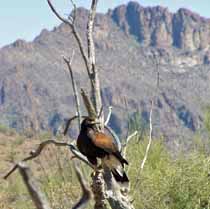
There were a large number of animals which live in the desert on display. The areas they were kept in were quite natural for the most part, as the museum is actually part of the desert, and the man-made areas appeared to be as natural as possible.
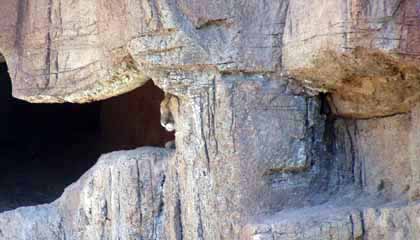 Can
you find the cougar?
Can
you find the cougar?
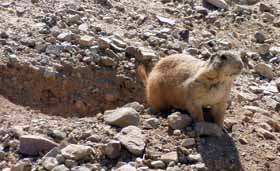 Everyone loves the prairie dogs.
Everyone loves the prairie dogs.
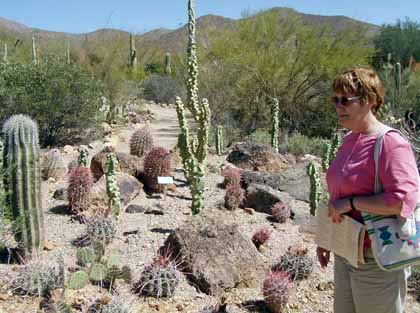 Cactus
everywhere - beautify scenery
Cactus
everywhere - beautify scenery
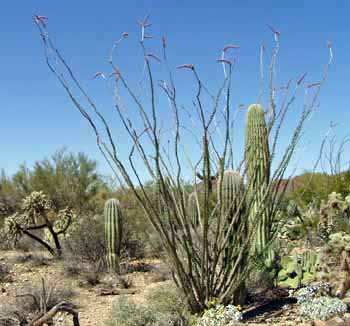
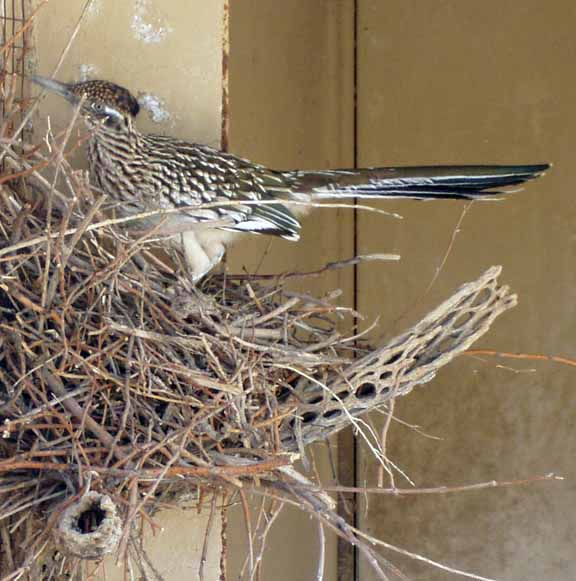
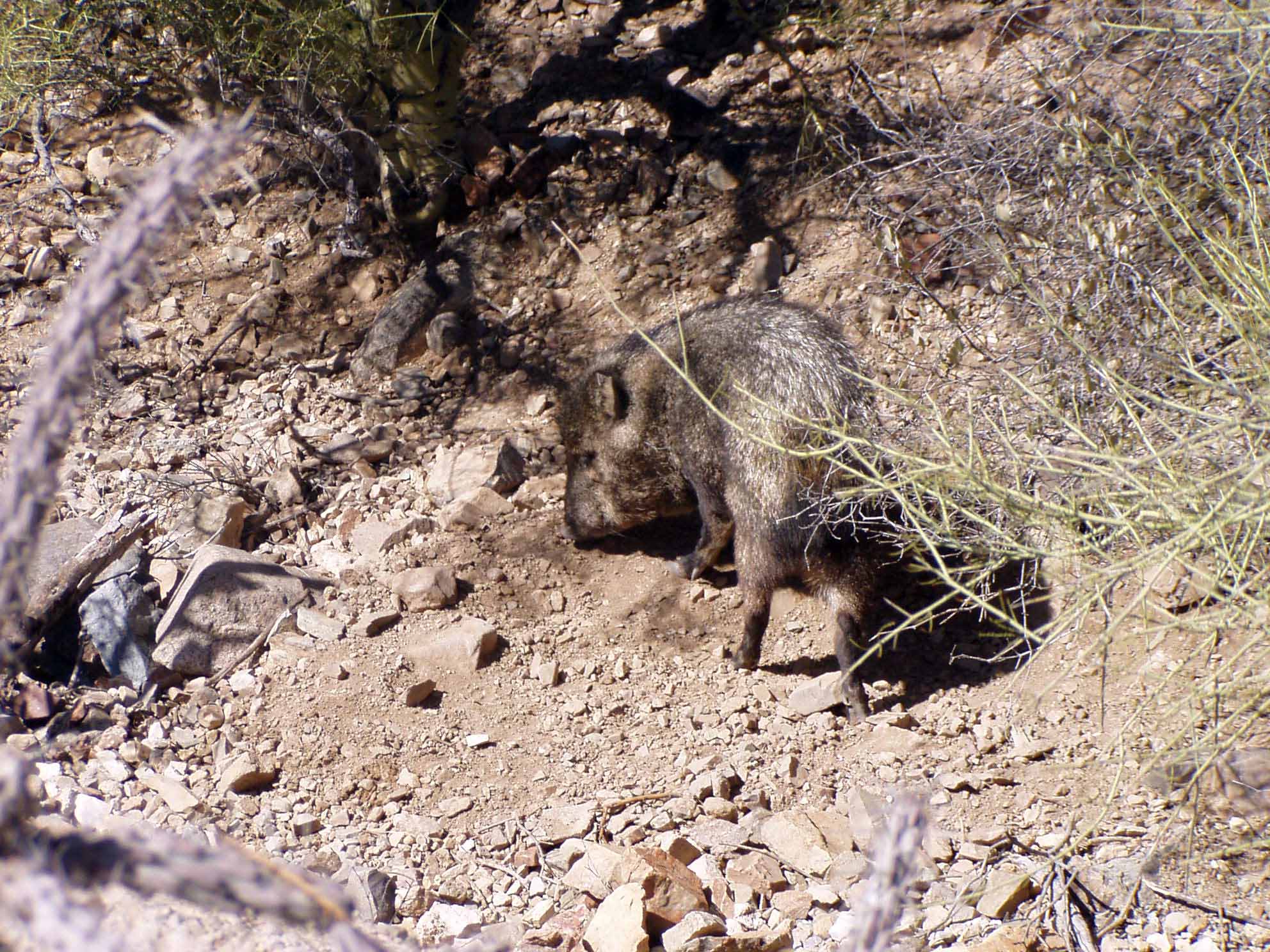 Road
runners, hogs, sap suckers and sheep - an eclectic combination
Road
runners, hogs, sap suckers and sheep - an eclectic combination
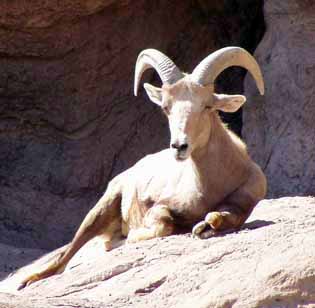
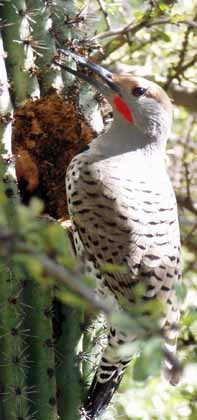
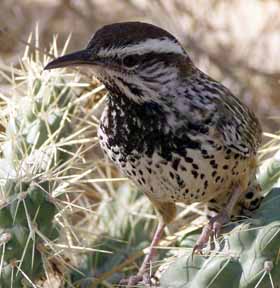
And then the trip ends with the Saguaro National Park
We stumbled onto the park after the drive around the Desert Museum. Jackie had always wanted to see saguaro cactus and was pretty overwhelmed by them. You should have seen her excitement when we drove up to the hotel and she saw her first saguaro in front of the place!
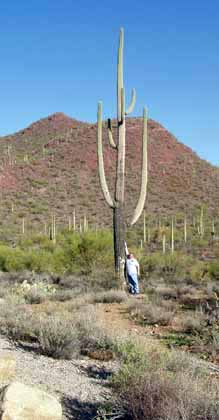 I've
got to admit I was then overwhelmed when we first drove into the Nation
Park. We had not driven a half mile when we saw this one. I can only
guess, but its got to be between 40 and 50 feet tall.
I've
got to admit I was then overwhelmed when we first drove into the Nation
Park. We had not driven a half mile when we saw this one. I can only
guess, but its got to be between 40 and 50 feet tall.
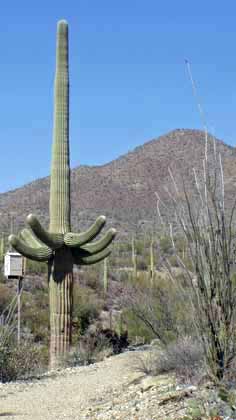 One of the greatest problems
One of the greatest problems 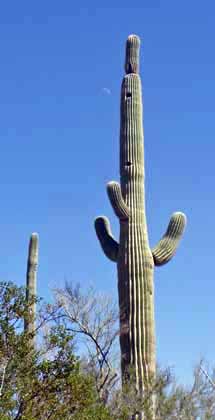
with the saguaro cactus is theft. These cactus are being stolen to be placed on the lawns of homes and displays for places like our hotel. For all their size, they are fragile - they should not be moved, and then only with great care. Too many that are moved are basically destroyed. Their age is unimaginable. If I recall correctly, they have to be nearly 100 years old before they have their first branch. Just imagine how old these cactus are. A real crime to move them.
>>>>>>>>>>>>>>>>>>> - - - - - - - - - <<<<<<<<<<<<<<<<<<<
There are too many memories to ever possible replicate with a few pictures and my poor words. The American Orient Express, alone, was a once in a lifetime experience for us. Mexico was wonderful. We've now been to Mexico several additional times. We now appreciate even more the places we visited, the things were saw and the sights in the Copper Canyon.
As with many other trips we've taken, in the end, the most valuable, long lasting benefits of travel are the friends you make. All our trips have resulted in continuing emails, shared pictures and invitations to visit. However, this was one of those special trips where we met special people, and made lasting friendships.
What were the most valuable benefits of this trip? See them below -
Charles, Pam, Andy and Cathy
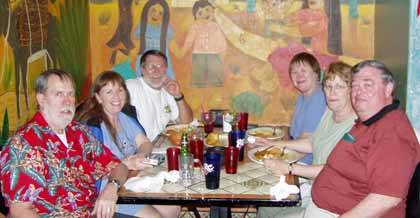
- - - - - - - - - - - - - - - - - - - - - - - - - - -- - - - - - - - - - - - - - - - - - - - - - - - - - - - - - -- --
A Sad Addendum
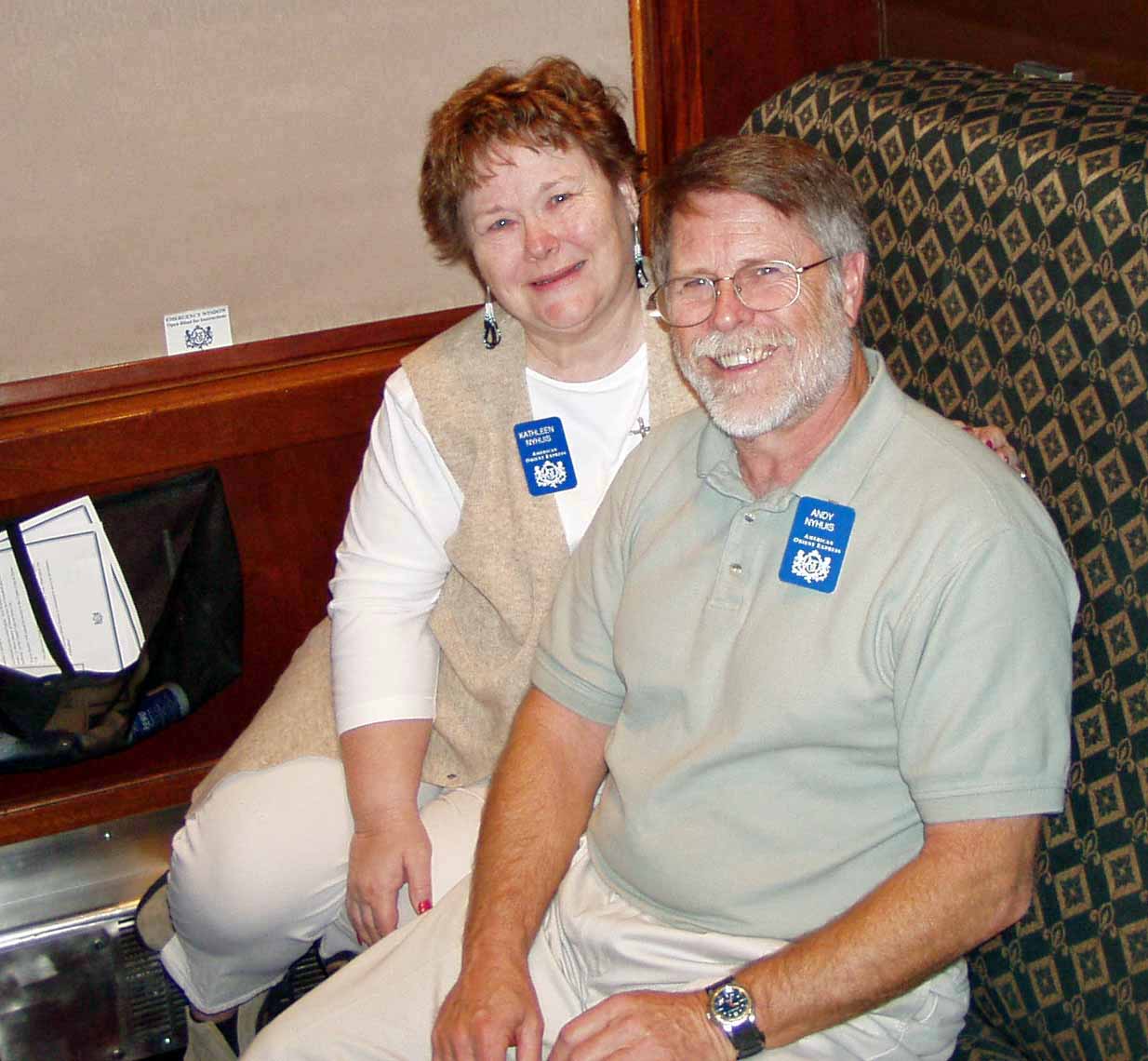
Andy has passed on - a victim of Alzheimer's
A good man; we all miss him
>>>>>>>>>>>>>>>>>>>>>>>> - - - - - - - - - - - - -<<<<<<<<<<<<<<<<<<<
But to end on an affirmative note -
Meet my Mexican doctor.
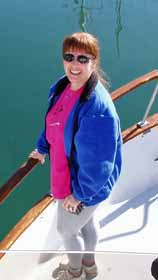
Yes, you've seen Pam earlier. However, I owe her a special debt of gratitude. I have this terrible habit of sampling native street food. Don't know if it was the grilled chipotles on fresh tortillas, or the fruit drinks, or the sweets made from corn, or one of the other special things I tasted, but something resulted in an outstanding case of - shall we say - the runs. So, here we are in a small, dusty Mexican town and I'm in agony. I don't speak or read Spanish and this is my first visit to Mexico, so I couldn't therefore spot a pharmacy, and if I could, I didn't know how to ask for what I needed.
Dr. Pam stepped right in. She asked the problem. She then wrote a "prescription" - the Spanish word for pharmacy and the Mexican name of a specific over the counter medicine. Found the store - gave the written scrap of paper to the clerk - took two pills immediately - all cured!
We've traveled together and visited since this first trip. I've learned; if ever in need of a bandage, an aspirin or any other cure or remedy - go see Dr. Pam!
~ ~ ~ ~ ~ ~ ~ ~ ~ ~ ~ ~ ~ ~ ~ ~ ~ ~ ~ ~ ~ ~ ~ ~ ~ ~
PLEASE READ: I Use WIKIPEDIA - Here's How